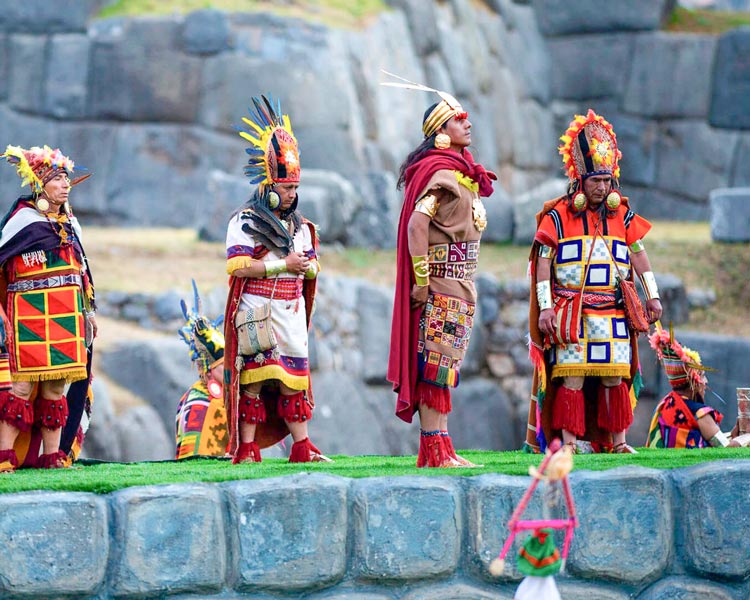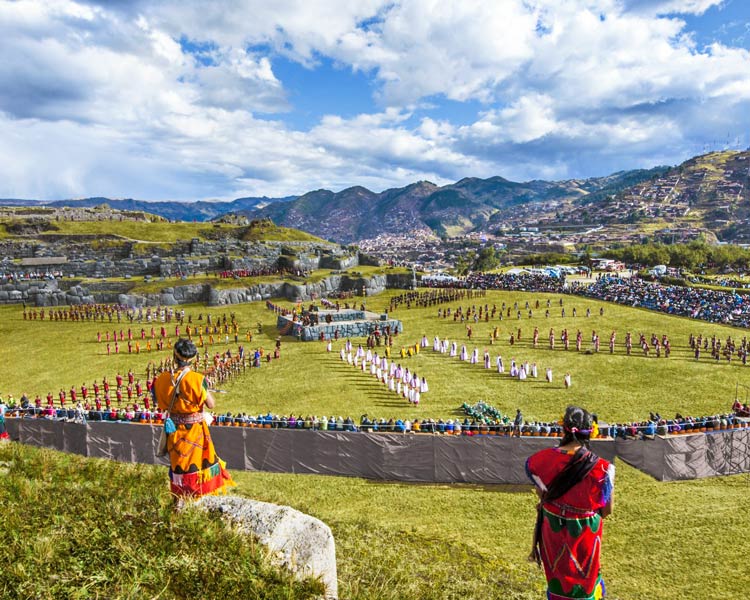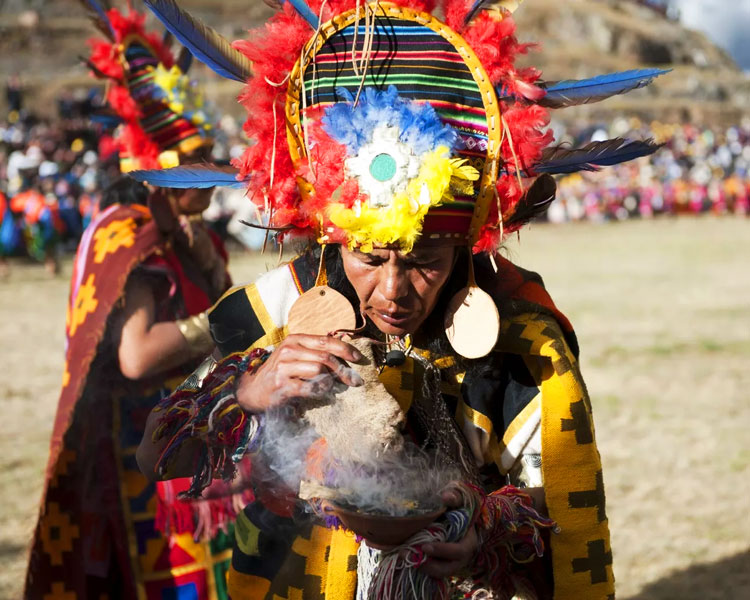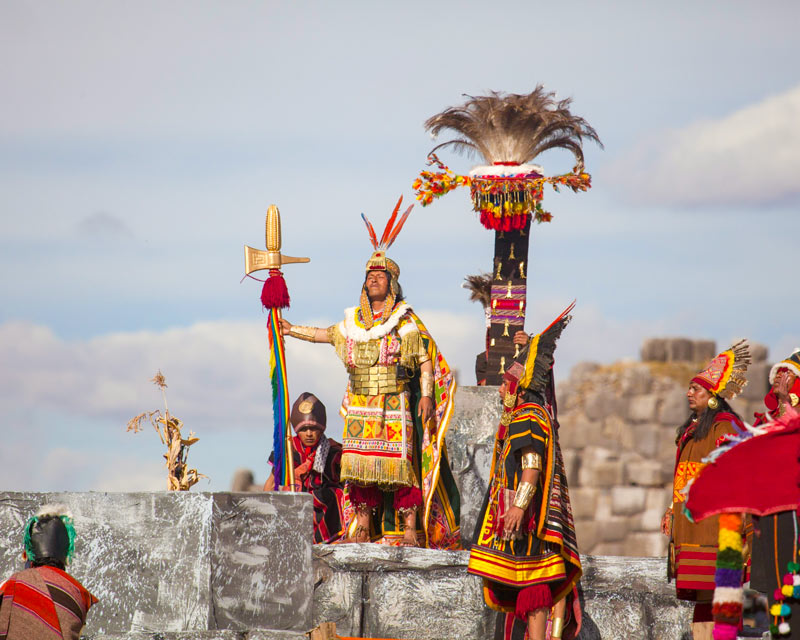Meaning of Inti Raymi and its connection to the Winter Solstice
The Inti Raymi festival in Inca times was not only associated with honoring the Sun God by offering tributes and petitions, but was also closely linked to the Winter Solstice. In this context, the celebration took on even greater significance, as it seemed to be a day that paused to celebrate everything the Sun, the Earth, and life had provided, as well as to thank each of them for their good fortune and harvests.
Content:
What is the meaning of Inti Raymi?

Inti Raymi has several meanings. In the Inca era, this celebration in honor of the sun god lasted almost 15 days and paid tribute to many deities, as well as to the winter solstice, a time when the harvests that had been waiting throughout the season to be harvested were gathered.
Inti Raymi is in Quechua, the mother tongue of the Incas, which means: Inti – Sun and Raymi – Festival. The Festival of the Sun shows us a little of what the polytheistic religion of the Inca culture was, because during the 15-day festival tribute was paid to many of their gods such as Pachamama (Mother Earth), Mama Quilla (Mother Moon), Illapa (God of the Storm), the God Viracocha (Creator Entity), as well as and as a central axis to the Sun god who was the most important deity for the Incas.
During the festival, the entire Tahuantinsuyu population would gather, bringing offerings for the Sun God. Through rituals and sacrifices, these tributes were offered to their deities in the hope of bringing good fortune to the entire empire, as well as to their lands and agriculture.
Secure your spot at the Inti Raymi festival
Don’t miss the opportunity to experience one of the most iconic festivals in Cusco and the world. Reserve your tickets through our Entradaintiraymi website to secure your spot at this unique event. The celebration is organized into three sections: the red zone, the green zone, and the orange zone, each offering you different perspectives and experiences to enjoy the magnificent celebration. Take advantage of this opportunity to be part of the ancient tradition of Inti Raymi and experience firsthand the Incas’ connection with the Sun God!
What is the Winter Solstice?

The entire territory of Tahuantinsuyo was located within the Southern Hemisphere, a hemispheric region where, to this day, the winter solstice occurs around June 21st. This marked the beginning of the harvest season, as well as the longest night and shortest day of the year.
From an astronomical perspective, during the winter solstice the sun reaches its furthest point and remains still for a moment, before slowly beginning to “return” and giving off more light each day.
Within Inca culture, and to this day in Andean culture, it is considered a sacred moment. According to interpretations, the winter solstice is a time when the sun seems to be reborn, bringing a new cycle of prosperity to life and crops.
What is the connection between Inti Raymi and the Winter Solstice?

Inti Raymi (June 24) is celebrated on dates very close to the winter solstice, and this is not just a coincidence, but because the celebration in the Inca era lasted many more days, it meant that one day was set aside solely in honor of the Winter Solstice.
It was a mystical day for the inhabitants of Tahuantinsuyo, because they could see how the night had almost the same duration as the day, which conferred greater veneration to the Sun god, by providing them with phenomena that were very difficult to explain and which they attributed to the power that this star had.
During the Inca period, many temples were built that served as natural observatories of the sky. Inca culture was closely connected to the stellar phenomena that occurred, from knowing how to predict them to paying homage to them for all the “magic” that witnessing them conferred. Many of these temples can still be found today in places like Qoricancha (Temple of the Sun), the Inca citadel of Machu Picchu, and the Ollantaytambo fortress.
The Winter Solstice was a time when the entire Inca people witnessed the sacred. They would see the sun appear for a shorter time and pray for its return. The deity of the Sun was so important to the Incas because it was thanks to him that they had everything: the harvest, the weather, power, and life.
What will I see at Inti Raymi?
The Inti Raymi festival is celebrated today on June 24th. On this day, a show commemorating the Inca festival is performed in three locations. The celebration takes place at: El Qoricancha (where the first show takes place), the Plaza de Armas (where the second show takes place), and Sacsayhuamán (where the third and main show takes place).
Among the most relevant activities that we will see during Inti Raymi are rituals and offerings in tribute to the Sun God, such as the following:
| Main rituals during Inti Raymi | ||
|---|---|---|
| Ritual or Ceremony | Description | Headquarters of the Ritual |
| The sacrifice of the flame | In this reenactment, the Inca high priest (Willaq Uma) is in charge of sacrificing a black llama (a symbol of purity) in the presence of the Inca. Using a ceremonial knife (Tumi), he opens the llama’s chest and removes its heart and organs. In the reenactment, these serve to interpret the future of the Tahuantinsuyu empire according to its status. | Sacsayhuamán Fortress |
| The chicha ritual | In this ritual, the Inca takes a golden cup (Kero) filled with chicha and offers it to the Sun God as a sign of veneration. He then pours the contents into a trough that will carry the liquid to the Qoricancha. He also takes a silver cup filled with chicha, toasts the sun, and drinks it, then invites his entourage to share. | Sacsayhuamán Fortress |
| Rite of the Sacred Fire | This ritual consists of lighting a fire with the reflection of the sun and a gold bracelet in a container filled with wool, symbolizing with its flame the trust and protection that the sun god gives to the Inca and his people. | Sacsayhuamán Fortress |
| Rite of the Sankhu (sacred bread) | In this ritual, the priests bring baskets of corn cakes (sankhu). The high priest then blesses them with the llama’s blood and then asks the Inca and his entire entourage to serve themselves a portion of this sacred food. In this way, they break the fast they have undertaken in preparation for Inti Raymi. | Sacsayhuamán Fortress |
| Coca leaf ritual | In this ceremony, through the reading of coca leaves, the aim is to learn predictions about the future of the empire regarding its prosperity and well-being. | Parade ground |
| Ceremony of the Meeting of the Times | At this event, the mayor of the city of Cusco receives from the Inca a Khipu (woven fabrics as a language of the Inca culture) where the knowledge of the Inca people such as Munay, Yachay, Llankáy (wanting, knowing, working) are represented. | Parade ground |
| Sun Salutation Ceremony | This is the first Inti Raymi ceremony, where the Inca asks the Sun for its blessing to perform the ceremony in his honor with all the best omens. | Qoricancha (Temple of the Sun) |
Recommendations to improve your Inti Raymi experience

- You can connect further with Andean traditions through rituals such as earth payments or prediction ceremonies through coca leaf readings, to immerse yourself in the culture and better understand Inti Raymi.
- Each of the ceremonies are merely acts of representation, but Andean culture still preserves these traditions, which dictate much of the daily life of Andean people.
- Remember to bring plenty of water to avoid dehydration during your tour. Inti Raymi usually occurs during a very hot season in Cusco, so it’s important to take precautions to protect yourself from it.
- Arrive early at each of the Inti Raymi performance stages to make sure you don’t miss a single detail of this incredible celebration.
- The Inti Ray takes place during the dry season, which runs from April to October in Cusco. It’s the perfect time to visit all the attractions Cusco has to offer.
- There are three types of seats available for you to watch Inti Raymi in Sacsayhuamán: Green Stand, Red Stand, and Orange Stand. Reserve them in advance through our Entradaintiraymi page.
- Purchase your ticket for the main Inti Raymi show in Sacsayhuamán through our website. Remember, they sell out quickly. This is your chance to experience the most important Inca festival.
